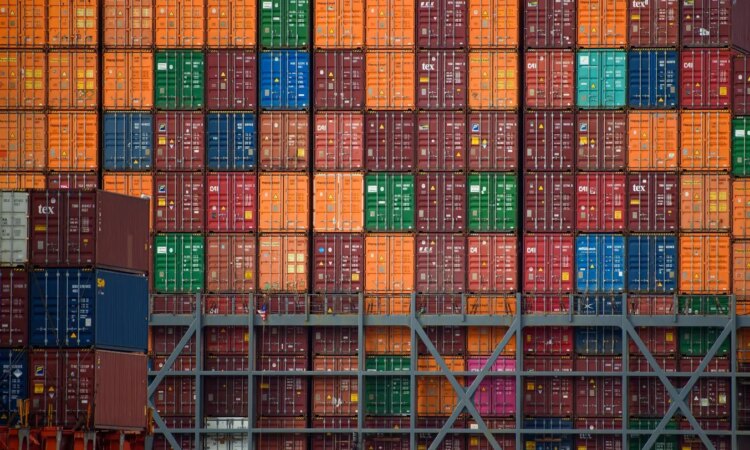The AI Logistics Revolution And Why Venture Capital Is Pouring Into Supply Chain Automation

HAMBURG, GERMANY – OCTOBER 03: Shipping containers stand stacked at Hamburg Port on October 3, 2022 in Hamburg, Germany. The German economy, and German industry in particular, are facing a foreboding combination of skyrocketing energy costs, the possibility of energy shortfalls this coming winter and a likely German economic recession, all of which are consequences stemming from Russia’s ongoing war in Ukraine. (Photo by Gregor Fischer/Getty Images)
Getty Images
Few industries of this size remain as fragmented and labor-intensive as logistics and supply chain management. Armstrong & Associates estimates the third-party logistics segment alone accounted for $1.27 trillion in 2023, underscoring the scale of the opportunity. But scale does not mean efficiency. For every truck driver moving goods, there are roughly two employees behind the scenes handling paperwork, compliance checks, and shipment tracking, much of it still manual.
This imbalance is no longer sustainable. The American Trucking Associations anticipates a shortfall of 160,000 drivers by 2030, and administrative hiring pipelines are facing similar strain. This pressure is accelerating demand for automation. Emerging AI-driven platforms are already showing they can take over the bulk of repetitive back-office processes, in some cases eliminating up to 90% of manual workflows.
Why VCs Are Betting Big on Logistics AI
Venture capitalists are increasingly attracted to logistics technology as cost and efficiency pressures have hit a breaking point, but on the other hand AI is finally good enough. Following areas present major opportunities for the VCs:
Proven unit economics. Unlike many AI applications still searching for ROI, logistics automation delivers immediate, measurable savings. Companies like Arnata report 91% reductions in back-office manhours, translating directly to bottom-line improvement.
Massive addressable market with proven pain points. Unlike many emerging tech categories, logistics presents a clear, quantifiable problem: administrative overhead consumes 20-30% of shipping costs through broker fees alone, while manual processes create delays that cascade through supply chains. McKinsey estimates that AI and advanced analytics could generate $1.3 trillion to $2 trillion annually in economic value across the supply chain and manufacturing sectors.
Recession-resistant fundamentals. Goods must move regardless of economic conditions. The logistics industry proved remarkably resilient during recent economic turbulence, with e-commerce growth and reshoring trends driving sustained demand.
Technology adoption inflection point. After decades of resistance to digitization, logistics companies are finally embracing automation. The pandemic accelerated this shift dramatically, creating an opening for startups to displace legacy processes.
Advances in generative AI and workflow automation can handle unstructured data (bills of lading, invoices, shipment updates) that were historically too messy to digitize. Large language models (LLMs) can process customs codes, trade regulations, and multilingual documentation in seconds—something rule-based software couldn’t do.
The Competitive Landscape
AI Logistics Market Map
Josipa Majic Predin
The Incumbents
Traditional freight brokers and third-party logistics providers (3PLs) like C.H. Robinson, XPO Logistics, and J.B. Hunt have dominated the industry for decades. These companies generated massive revenues, C.H. Robinson alone posted $17.5 billion in 2023, by serving as intermediaries between shippers and carriers. However, their business models depend on manual processes and opacity that AI threatens to eliminate.
Many incumbents are now scrambling to add technology layers to their operations. C.H. Robinson acquired Freightquote and launched its Navisphere platform, while XPO invested heavily in its Connect technology. Yet these efforts face the innovator’s dilemma: true automation threatens their high-margin brokerage businesses.
Big Tech’s Play
Technology giants recognize logistics as a strategic frontier. Amazon has built a massive logistics network that rivals UPS and FedEx, investing over $61 billion in shipping and fulfillment in 2022 alone. The company’s logistics operation now delivers more than half its own packages, fundamentally restructuring the industry.
Google Cloud and Microsoft Azure compete aggressively for logistics customers, offering AI and machine learning tools for supply chain optimization. Alphabet’s Waymo is developing autonomous trucking, while Tesla’s Semi promises to electrify long-haul freight.
The Challenger Startups
A new generation of AI-native startups is attacking the industry from multiple angles:
Direct carrier-shipper platforms. Companies like Zerobroker (now evolved into Arnata) raised $6.5 million in seed funding to eliminate freight brokers entirely, connecting shippers directly with carriers while using AI to automate 90% of logistics tasks. This model removes the 20-30% broker commission that has long inflated shipping costs.
AI agent platforms. Arnata’s latest offering, Arnata 2.0, represents the next evolution: autonomous AI agents that handle specific logistics functions—dispatching, tracking, billing, safety compliance—without requiring new platforms or integrations. The company’s claim of closing $1 million in ARR in a single week signals extraordinary market demand.
Predictive analytics players. Startups like project44 and FourKites raised hundreds of millions to provide real-time visibility and predictive analytics across supply chains. Project44 achieved unicorn status with a $1.2 billion valuation in 2021.
Autonomous vehicle specialists. Aurora Innovation, TuSimple, and others are developing self-driving trucks that could eliminate driver shortages while reducing costs by 30-40%, according to Morgan Stanley research.
The Investment Thesis
The venture capital community’s enthusiasm for logistics AI rests on several pillars:
Fragmentation creates opportunity. The trucking industry includes over 1.2 million carriers, with 97% operating 20 or fewer trucks according to the American Trucking Associations. This extreme fragmentation makes coordination expensive and creates natural demand for platforms that aggregate and automate.
Network effects and data moats. Successful logistics platforms benefit from powerful network effects—each additional carrier and shipper makes the platform more valuable. The operational data these platforms capture creates proprietary datasets that continuously improve their AI models, building defensive moats against competitors.
Expansion potential. Logistics automation platforms can expand horizontally across transportation modes (trucking, rail, ocean, air) and vertically into adjacent services (warehousing, customs, insurance). This creates multiple paths to scale beyond initial wedge products.
Flexport, a digital first logistics platform with $2.1 billion in 2024 revenues, has moved beyond just freight forwarding by acquiring Shopify’s logistics/fulfillment operations, adding warehousing and e-commerce distribution to its mix. This gives it alternate levers to lean on when international trade slows.
M&A exit opportunities. Strategic acquirers are actively shopping for logistics technology. In recent years, Uber acquired Transplace for $2.25 billion, RXO bought Coyote Logistics for $1.05 billion, and numerous other transactions validated logistics tech valuations.
Market Dynamics and Risks
Despite the enthusiasm, logistics AI faces real challenges. Implementation complexity remains high—each customer requires customization for their specific workflows and systems. Regulatory compliance adds layers of complexity, particularly around driver safety and hours-of-service rules.
Margin pressure is intense. While AI can reduce costs dramatically, competitive dynamics may force companies to pass most savings to customers, limiting profitability. The industry’s price sensitivity means startups must achieve massive scale to succeed.
Labor displacement concerns create political and social risks. Automating jobs that support millions of families will inevitably trigger resistance from workers and unions, potentially inviting regulatory intervention.
The Verdict
The AI revolution in logistics represents a genuine inflection point rather than hype. The combination of massive market size, clear ROI, and demonstrated traction from startups like Arnata suggests this wave of innovation has staying power.
For venture capitalists, logistics AI offers a rare combination: enormous addressable markets, proven product-market fit, and strong unit economics. As Arnata founder Georgy Melkonyan noted, “Logistics is the ultimate stress test for AI. If AI can run freight, it can run any repeatable operation.”
Arnata founder Georgy Melkonyan
Arnata
The startups capturing venture dollars today aren’t just building features, they’re reconstructing the fundamental infrastructure of how goods move through the global economy. In a world increasingly dependent on efficient supply chains, that’s a bet worth making.
The question is no longer whether AI will transform logistics, but which companies will capture the value. With billions in venture funding flowing into the sector and startups demonstrating 90%+ efficiency gains, the transformation is already underway. Traditional players that fail to adapt risk obsolescence, while AI-native challengers race to define the industry’s future.
For investors willing to navigate the complexity, logistics AI represents one of the most compelling enterprise opportunities of the decade.





